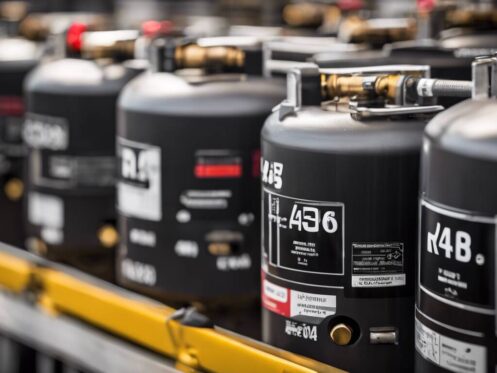In an era of continuous evolution and environmentally conscious choices, the HVAC industry isn’t immune to constant updates and innovation. The Hudson River isn’t just named after Henry Hudson; it is also a metaphor for our journey towards a sustainable future. Welcome aboard as we cruise together to the latest revelation in the HVAC world – R-454B refrigerant, commonly known as Puron Advance. This advanced solution offers not just coveted energy efficiency but also chases sustainability goals by significantly reducing global warming potential (GWP). So, brace yourself as we delve into understanding how this cutting-edge development revolutionizes the HVAC landscape and its implications for your business and the planet.
Overview of R-454B (Puron Advance)
As the search continues for more environmentally friendly and efficient alternatives to refrigerants, manufacturers are now turning to R-454B (Puron Advance), which is a blend composed of mildly flammable hydrofluoroolefin (HFO) 1234yf and HFC 32. This particular refrigerant has been touted as an eco-friendly option with lower global warming potential (GWP) compared to HCFC and HFC alternatives.
R-454B has some notable features that make it attractive to the HVAC industry. For starters, this refrigerant has a GWP of 466, which is significantly less than the commonly used R-410A, which has a GWP of around 2000. As per the UN Montreal Protocol Kigali Amendment’s requirements, the HVAC industry aims to transition fully to R-454B by 2023 while reducing HFC production and consumption by 85% over the next 15 years as per the American Innovation and Manufacturing (AIM) Act of 2020 mandate.
These regulations have led several manufacturers including Carrier, Mitsubishi Electric, Trane, and Johnson Controls, among others; to incorporate R-454B in their product designs.
How It Compares to HCFC and HFC Alternatives
In comparison to its predecessors like HCFCs and HFCs, how environmentally friendly is R-454B?
When looking at GWP or Ozone depletion potential (ODP), as found in HCFCs and HFCs, it becomes apparent that R-454B poses fewer environmental hazards. As noted previously, compared to R-410A refrigerant that has been widely used for various HVAC applications over the past two decades, Puron Advance reduces GWP emissions up to 77%. Additionally, it has zero ODP hence does not contribute to ozone depletion.
Privately owned buildings that use R-410A refrigerants need not fret as transitioning to R-454B is gradual, and regulations do not require immediate replacement of pre-existing systems. However, any future HVAC installations will have to utilize the latest alternatives like Puron Advance.
With Puron Advance, there are concerns about equipment compatibility, especially when gauges and performance are compared with other refrigerants like R-410A, which was widely used in HVAC systems. And since this is a relatively new development, HVAC contractors may lack the necessary skills, tools, knowledge and experience to work effectively with the novel refrigerant.
Imagine replacing an older refrigerant with Puron Advance in your HVAC system only to realize that you cannot operate it due to compatibility issues or safety concerns. In such cases, consulting experienced HVAC professionals like our team at Central Aire Heating & A/C, Inc. can make quite a difference.
- According to Carrier, Puron Advance (R-454B) results in a 75% reduction in Global Warming Potential (GWP) compared to the current R-410A refrigerant with a score of 466 GWP.
- EPA’s push to limit GWP of refrigerants to 700 by 2025 is met and exceeded by Puron Advance.
- The switch from Puron to Puron Advance does come with a change in flammability class, moving into the mildly flammable A2L category, however, it is important to note that A2L refrigerants like R-454B are considered difficult to ignite and have an extremely slow flame speed.
Environmental Impacts and Global Warming Potential
The R-454B or Puron Advance refrigerant, has a significantly lower Global Warming Potential (GWP) compared to older, commonly used refrigerants like R-410A. The GWP of R-454B is 466, which is significantly less than R-410A’s GWP of 2,088. This means that the use of R-454B results in a significant reduction in greenhouse gas emissions contributing to climate change. The low GWP value indicates Puron Advance is an excellent alternative and aligns with the HVAC industry’s ongoing efforts towards promoting eco-friendly practices.
Think about it as switching from gasoline to electric cars; while gasoline guzzling cars can get us from point A to B, electric cars are more sustainable, reducing carbon footprints.
The adoption of this refrigerant offers several benefits beyond environmental factors. It enhances energy efficiency and performance levels compared to previous refrigerants. In addition, it helps firms meet regulatory requirements, achieve sustainability goals proclaimed by their companies or mandated by governing bodies.
An additional advantage is that many large HVAC system manufacturers have already begun offering products compatible with using R-454B as replacement refrigerants for systems previously using other alternatives.
The Ozone Layer Interaction sheds light on how R-454B interacts with ozone layers and its implications on public health and safety.
Ozone Layer Interaction
R-454B belongs to the hydrofluoroolefin (HFO) class of refrigerants with zero ozone depletion potential(ODP). Ozone depletion refers to the thinning of the ozone layer seen mostly around regions surrounding the poles, due to the use of chemicals containing chlorine such as chlorofluorocarbons (CFCs). The impacts of ozone depletion are well documented, including increased skin cancer cases and weakening human immune systems.
The use of R-454B poses no such risk, making it an eco-friendly replacement for CFCs. However, while R-454B doesn’t deplete the ozone, this doesn’t mean it cannot be harmful during accidental leaks into the atmosphere.
Therefore, when handling it, preventative measures need to be taken to ensure that exposure is limited and accidents prevented. Puron Advance can still pose a safety threat if not handled with care. As with all refrigerants, adherence to proper safety guidelines when using R-454B is of utmost importance.
It’s crucial always to wear personal protective equipment and maintain well-ventilated workspaces.
Adopting R-454B as a standard refrigerant in HVAC systems may take a few years, but early adopters have already made significant strides. Gradual implementation ensures a smooth transition for firms with specific equipment needs into compatibility levels of using Puron Advance refrigerant.
Safety and Flammability Aspects
R-454B has necessitated a shift in flammability classification. While it’s mildly flammable, it falls within the A2L category of refrigerants, defined by international standard EN 378 as having a lower limit of flammability (LFL) above 0.1% but not exceeding 3%.
While this may raise some concern, A2L refrigerants like R-454B have a low ignition energy, which means that they are tough to ignite. In addition, they pose no significant threats to homeowners or technicians during installation or maintenance. This is because R-454B has been designed with safety measures that include an integral dissipation system that detects leaks and ensures that the dissipated refrigerant is filtered before release into the atmosphere.
That said, HVAC service providers should receive suitable training and have carrying equipment while dealing with mildly flammable refrigerants such as R-454B. Homeowners and business owners can enjoy efficient heating and cooling without any hazardous repercussions.
Cost Implications and Regulatory Mandates
The cost implications of the new refrigerant cannot be overlooked. For one, its production is not yet widespread, which means that demand often surpasses supply leading to higher prices for initial purchase and recharges.
Despite this, there are many potential long-term cost savings associated with R-454B. With an EPA approved GWP of just 466 – below the set threshold of 700 starting in 2025 – it reduces environmental impact significantly and makes compliance with air quality regulations less strenuous. Also, the improved energy efficiency compared to R-410A could lead to significant operational savings both at home and businesses.
As part of wider efforts to phase out environmentally damaging chemicals, a further regulatory mandate will require that HFC production be cut by up to 30%. This shift creates longer wait times for refrigerant recharge services, which means that property owners may have to plan long-term around a maintenance schedule.
Air Conditioning and Heating Performance
Air conditioning units that use R-454B refrigerant demonstrate impressive energy efficiency and environmentally friendly characteristics. This next-generation refrigerant has excellent cooling capabilities, and it is ideal for climates with high temperatures like those found in many parts of the United States. Unlike its predecessor, R-410A, it does not contribute to ozone depletion since it doesn’t contain chlorine atoms.
To put things into perspective, consider the SEER rating of air conditioning systems. R-454B enables HVAC units with SEER ratings up to 25 or higher, versus the SEER ratings of a system using R-410a ranging from 14 to 20.
This means you enjoy cooler temperatures while using less energy throughout summer months, which makes it an economical solution for homeowners looking to reduce utility bills. The improved performance is attributed to the lower discharge temperature, increased flow rate, and better lubricity provided by Puron Advance’s composition.
It’s essential to emphasize that even though a unit might operate on a more efficient refrigerant type like R-454B, maintenance remains crucial in ensuring your system works optimally over time. Regular cleaning ensures no clogs or internal damage leads to lower airflow and increased energy costs.
Moreover, Puron Advance performs well in both split system or package unit applications. Being a non-flammable refrigerant, there is also no need for new safety controls installations since existing safety devices can sufficiently handle Puron Advance.
Think about how proper car maintenance can lead to increased mileage over time. Similarly, regular HVAC maintenance will help increase performance and extend its life span.
While the shift towards more eco-friendly refrigerants such as R-454B provides numerous environmental benefits and energy savings: some cons exist in replacing AC units still operational on older refrigerants. It may be more cost-efficient in situations where replacement is necessary due to repairs required on an older unit to opt for R-454B refrigerant instead.
In conclusion, the HVAC industry is experiencing a change towards a greener AC regime. A switch to R-454B refrigerant presents numerous benefits in terms of energy efficiency, reduced environmental impact and cost savings over time. Given that it’s yet to be widely used in the USA, it’s expected that Puron Advance systems’ cost might be higher than units incorporating traditional refrigerants. Nevertheless, the long-term benefits are worth taking into consideration when deciding on the best AC solution for your home.
Stay ahead of the HVAC curve and ensure your home’s comfort by partnering with Central Aire Heating & A/C, Inc. – your trusted experts in navigating the R-454B (Puron Advance) transition; call us today at 318-747-4965 for personalized guidance and solutions.


